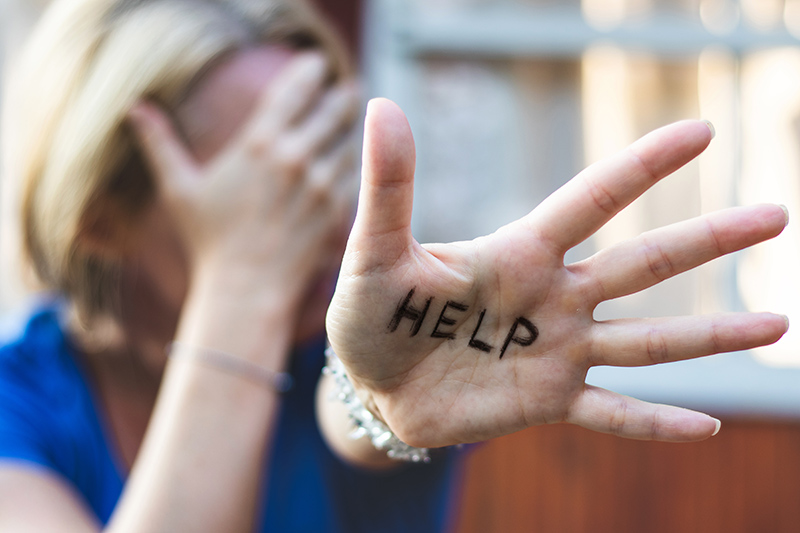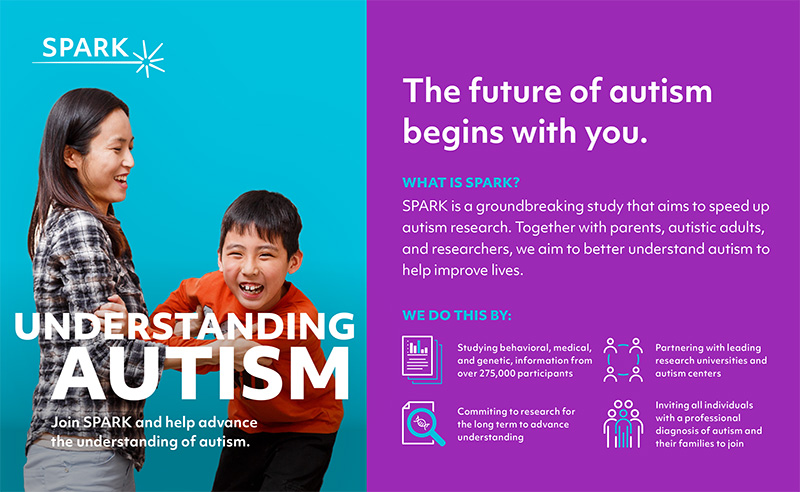This article contains information about suicide and suicide prevention. For help 24/7, please call or text the U.S. Suicide and Crisis Lifeline at 988.
After being bullied at school, the preteen boy came to believe that no one would care if he died. His therapist, whom he had been seeing for depression, told his parents to take him to the hospital for his suicidal thoughts. It was the second such hospitalization in his young life.

As his parents learned, their son is not alone. Youth who have autism, as he does, face a higher than average risk of having suicidal thoughts and behaviors. “I think the depression and anxiety cohabitate with autism,” says his mother, who participates in the SPARK autism research study. It’s true that autistic youth are more likely to have mental health conditions, and be bullied,1 than others their age.
Could doctors identify autistic youth who are thinking about suicide before a crisis occurs? Some researchers are studying tools that would allow them to do just that.
This is important because several studies have found that people on the autism spectrum have higher rates of suicidal thoughts, plans, or behaviors than the general population. And healthcare providers have a unique opportunity to help: people often visit doctors shortly before a suicide.2-3
“The majority of people who die by suicide have visited a healthcare provider months, and sometimes even weeks, before they die,” explains Lisa M. Horowitz, PhD, MPH, who researches suicide prevention for the U.S. National Institute of Mental Health (NIMH). “We think this is an opportunity, and a responsibility, for healthcare providers to identify people at risk and then bridge them to help.”
Horowitz led a team that created a suicide risk screening tool, the Ask Suicide-Screening Questions or ASQ, for typically developing children, teens, and adults. The four-question tool helps doctors quickly find out if someone is thinking about suicide, so they can intervene.
But what about autistic youth, who may have language and communication problems that could affect how they respond to such questions? Would the ASQ work with them?
Testing a Suicide Risk Screening Tool for Youth with Autism
In consultation with the NIMH, researchers are testing the ASQ, along with new questions, with youth who have autism and other developmental conditions. The study is underway at Kennedy Krieger Institute in Maryland and will soon include Nationwide Children’s Hospital in Ohio, says the lead researcher, Paul H. Lipkin, MD, a neurodevelopmental specialist who directs medical outpatient services at Kennedy Krieger. Researchers are comparing the ASQ to a longer, “gold standard” suicide assessment by a clinician, to see how well the ASQ identifies children at risk, he explains.
During a screening, a doctor or nurse asks youth four very direct questions about whether they have thoughts about dying or killing themselves. If they answer “yes” to any of those questions, the clinician then asks if they are having thoughts of suicide “right now.” Anyone who answers “yes” to any of the screening questions receives a suicide safety assessment to determine next steps.
To take part in the study, a child must be ages 8 to 17 and able to speak, although a communication device can be used to assist.
This current study builds upon previous work at Kennedy Krieger in 2017, when clinicians used the ASQ to conduct 3,800 screenings of youth visiting their clinics for developmental pediatrics, autism, neurology, and other medical specialties. They found the highest positive rate for suicidal thoughts, 12 percent, in youth at the autism clinic.4
Some of those youth were already seeing therapists, psychologists, or psychiatrists. Depression, anxiety, and other mental health conditions are more common in people with autism. But in other cases, no one had suspected a mental health problem in some children before they screened positive, Lipkin says.
Doctors referred children who screened positive to mental health providers, day programs, or a hospital emergency department, or they prescribed a new psychiatric medicine, depending on the level of suicide risk.4
Other studies have also found higher rates of suicidal thoughts or behaviors in autistic young adults and children. Among autistic people who were 25 years old or younger, 25 percent had thoughts about suicide, and 8 percent had made a suicide attempt, according to an analysis of 29 studies by researchers in Ireland. Less than 1 percent had died by suicide.5
As part of its suicide prevention plan, the American Academy of Pediatrics recommends that doctors screen all patients starting at age 12 for suicide risk and depression.
Screening Autistic Youth for Suicidal Thoughts and Plans
For researchers, one challenging part of screening children and teens for suicidal thoughts is getting patients and their parents to agree to it.
In the 2017 study of the ASQ tool, about 30 percent of the parents of autistic youth at Kennedy Krieger declined the suicide risk screening. Most of those parents did not believe their children would understand the questions or did not think they were at risk for suicide.4
A few worried that asking about suicide might be harmful. “Some families were afraid to introduce those types of questions for fear that they might make their children think about something they hadn’t thought about before,” Lipkin says. “And other parents said they believed that children with autism and intellectual disability were not capable of suicidal thinking or actions.”
There is less research on suicidal thoughts and behavior in people with both autism and intellectual disability. “Assessing suicidality in people with severe autism is very challenging, as intellectual disability and, more importantly, communication impairment, are significant barriers,” says child psychiatrist Matthew Siegel, MD, who researches severe autism for a sister study to SPARK.
One large study found that autistic people with intellectual disability are more likely to attempt suicide than other people. That same study found an even higher risk among autistic people who do not have intellectual disability. That study involved more than 2 million people in Sweden from 1987 to 2013.6
Autism and Repetitive Thinking
Could youth possibly start thinking about suicide, just because they were asked about it? “This is the biggest myth about screening, debunked by at least four research studies that say screening does not cause typically developing people to think about suicide,” says Horowitz of the NIMH. But autistic people are more likely to focus intensely on a topic, a kind of repetitive behavior.
Lipkin says his study is examining that question. “Our current study is looking at the whole notion of rigidity of thinking in autism, with a short follow-up to see if there’s been some persistent repetitive thoughts about death,” he says. “So far, it seems that those on the autism spectrum are not suggestible of suicidal thoughts as a result of the [screening] questions.”
Safety Planning for Someone with Suicidal Thoughts
Researchers at Kennedy Krieger and at hospitals in Pennsylvania, Ohio, and North Carolina will be studying an intervention for decreasing the short-term risk to autistic people ages 15 to 24 who have suicidal thoughts.
During a “Safety Planning Intervention,” doctors typically work with patients to make a plan to keep them safe while they receive therapy, medication, or other care. They discuss when to put the plan in action, things they can do to distract themselves, and emergency services they can use. “When someone is in a suicidal state, you want to distract them,” explains Horowitz, the clinical psychologist at NIMH.
Researchers want to see if modifications to the Safety Planning Intervention, which has been used with typically developing people, will help teens and young adults on the spectrum.
Modifications could include helping youth to identify their feelings and warning signs of a crisis, as well as finding autism-friendly activities to distract them from suicidal thoughts, says clinical psychologist Jessica Schwartzman, PhD, a researcher at Vanderbilt University Medical Center who is not involved in that study.
A safety plan may include activities such as time alone in a quiet, sensory-friendly room and doing something the youth enjoys, such as drawing or music, says Schwartzman, who researches depression and suicidal thoughts in autism.7 Some autistic teens may want to socialize with others in person, while others may prefer to distract themselves by chatting online, she says.
If their suicidal thoughts persist, youth can ask for help from relatives or other trusted adults, doctors, therapists, school counselors, or the 24/7 suicide prevention and crisis line at 988, Schwartzman says.
“Every child should have that [988] number in their phone so they can have someone to talk to at any hour,” Horowitz says.
Making the home safer for someone with suicidal thoughts is another important step in safety planning, Horowitz says. That may mean storing over-the-counter and prescription medicine, weapons, and ammunition safely away from children and teens with suicidal thoughts. “You want to make sure there are no lethal means available,” she says.
“When people are struggling with intense suicidal thoughts, they are not always thinking clearly. There are fundamental safety measures that people can take,” Horowitz says.
Screening for suicidal thoughts in children and teens, and seeking mental health treatment, can relieve their current suffering, Horowitz says. And it may possibly prevent future problems.
“Suicidal thoughts are a gateway to having psychiatric disorders as an adult. If you can have early intervention in this process, maybe you are preventing this gateway from opening, where you have a child growing up to be an adult with a lot of psychiatric problems. You have a chance to intervene on a developing person and spare them from a lot of suffering as an adult,” Horowitz says.
Lipkin, who has diagnosed and treated children on the spectrum for decades, encourages his fellow pediatricians and pediatric specialists to think about suicide screening and prevention now. “We all know the dramatic numbers now around mental health and suicide. It is a huge public health issue that is, little by little, getting the attention it deserves.”
Resources
- For help 24/7, please call or text the Suicide and Crisis Lifeline at 988 or call 1-800-273-8255. Online chat available.
- Text TALK to 741741 to reach the Crisis Text Line.
- Read the American Academy of Pediatrics’ Blueprint for Youth Suicide Prevention.
Read part one of this series, “Autism and the Troubling Risk of Suicide.”
Interested in joining SPARK? Here’s what you should know.
This article has been republished with permission from SPARK. You may view the original article, published on September 7, 2022, at https://sparkforautism.org/discover_article/suicide-prevention-autism/.
Footnotes
- Zablotsky B. et al. Autism18, 419-427 (2014) PubMed
- Laanani M. et al. J. Affect. Disord. 274, 174-182 (2020) PubMed
- Ahmedani B.K. et al. J. Gen. Intern. Med. 29, 870-877 (2014) PubMed
- Rybczynski S. et al. J. Dev. Behav. Pediatr. 43, 181-187 (2022) PubMed
- O’Halloran L. et al. Clin. Psychol. Rev. 93, 102144 (2022) PubMed
- Hirvikoski T. et al. Psychol. Med. 50, 1463-1474 (2020) PubMed
- Schwartzman J.M. et al. Pediatrics148, e2021052958 (2021) PubMed





